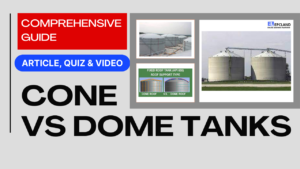1. Purpose of Rigid Supports
What is the primary purpose of rigid supports in piping systems?
Explanation: The primary purpose of rigid supports is to prevent vertical downward movement in piping systems and provide lateral support.
2. Characteristics of Rigid Supports
What characteristics do rigid supports possess according to the information provided?
Explanation: Rigid supports prevent vertical downward movement, may or may not prevent vertical upward movement, and allow for lateral movement and rotation.
3. Types of Rigid Supports
Which type of rigid support is designed to support two or more pipes?
Explanation: Trunnion supports are similar to dummy supports but are designed to support two or more pipes.
4. Applications of Rigid Supports
Where are rigid supports typically used according to the information provided?
Explanation: Rigid supports are typically used in areas where there is no need to allow for vertical thermal expansion or contraction and in piping systems subjected to high loads or in areas with a risk of fire or explosion.
5. Advantages of Rigid Supports
What is a notable advantage of rigid supports mentioned in the information?
Explanation: Rigid supports have the advantage of being simple to design and install.
6. Disadvantages of Rigid Supports
What is mentioned as a disadvantage of rigid supports in the information?
Explanation: Rigid supports can transmit vibration to connected equipment, which is mentioned as a disadvantage.
7. Selection of Rigid Supports
What factors influence the selection of the appropriate rigid support for a particular application?
Explanation: The selection of the appropriate rigid support depends on factors such as the weight, location, operating conditions, and type of piping system.
Short Article on Rigid Supports in Piping Systems
Rigid Supports
Rigid supports are a type of support used in piping systems to prevent vertical downward movement and to provide lateral support. They are typically used in situations where there is no need to allow for vertical thermal expansion or contraction. Rigid supports can be classified into two main categories:
- Shoe supports: These supports are typically used to support piping that is located on a floor or other flat surface. They are designed to carry the weight of the pipe and its contents and to prevent it from sagging.
- Hangers: These supports are typically used to support piping that is suspended from overhead structures. They are designed to carry the weight of the pipe and its contents and to prevent it from swinging or swaying.
Characteristics of Rigid Supports
Rigid supports have the following characteristics:
- They prevent vertical downward movement.
- They may or may not prevent vertical upward movement.
- They allow for lateral movement and rotation.
Types of Rigid Supports
There are several different types of rigid supports, including:
- Shoe supports: These supports are typically made of steel or concrete and are bolted to the floor or other supporting structure.
- Saddle supports: These supports are similar to shoe supports but are designed to support two or more pipes.
- Base plates: These supports are typically made of steel and are bolted to the floor or other supporting structure. They are designed to support large, heavy pipes.
- Dummy supports: These supports are typically made of steel and are welded to the pipe. They are used to provide lateral support and to prevent the pipe from vibrating.
- Trunnion supports: These supports are similar to dummy supports but are designed to support two or more pipes.
Applications of Rigid Supports
Rigid supports are typically used in the following applications:
- Piping systems that are located in areas where there is no need to allow for vertical thermal expansion or contraction.
- Piping systems that are subjected to high loads.
- Piping systems that are located in areas where there is a risk of fire or explosion.
Advantages of Rigid Supports
Rigid supports have the following advantages:
- They are simple to design and install.
- They are relatively inexpensive.
- They are very strong and durable.
Disadvantages of Rigid Supports
Rigid supports have the following disadvantages:
- They can transmit vibration to connected equipment.
- They can make it difficult to install and maintain piping systems.
Selection of Rigid Supports
The selection of the appropriate rigid support for a particular application depends on a number of factors, including:
- The type of piping system.
- The weight of the piping system.
- The location of the piping system.
- The operating conditions of the piping system.
Conclusion
Rigid supports are an important component of piping systems and can help to ensure the safety and reliability of these systems. When selecting rigid supports, it is important to consider the specific requirements of the application.
Table of Contents
Don’t miss the Course on Effective Isometrics Management: Check Now
Enrollment Link
Recommended courses (Published on EPCLand)
- Complete Course on Piping Engineering
- Basics of Piping Engineering
- Piping Layout Engineering
- Piping Material Engineering
- Piping Stress Analysis
- Material Requisitions
- Piping Material Specifications
- Valve Material Specifications
- Plant Design & Layouts-OISD 118
- Isometric Management
Library of Technical Articles
Don’t miss out the collection of 15+ articles on following topics:
- Basics of Oil and Gas Industry
- Valves
- Testing
- Tank
- Piping Bulk Items
- Pipe
- Metallurgy
- Piping Materials
- Layout
- Instrumentation
- Heat Exchanger
- Type of Contracts
- Codes and Standards
- ASTM Standards
- Articles on Piping Specialty Items
Video details of Complete Course on Piping Engineering
Why Enroll in the EPCLand
Proven Track Record– PTR
Activities & Achievements before launching EPCLand
- Published more than 50+ short courses
- 3000+ Enrolments
- More than 3,500,00 Minutes of watch hours in the last 2 years
- 4000+ Students in 100+ Countries
- Rating of 4+ out of 5
- 1000+ YouTube Videos
- 8K+ Subscribers
What Students will Learn
- Codes & Standards of the Energy Sector
- Piping Material Engineering
- Piping Layout Engineering
- Stress Analysis
Interesting facts
- All the published courses have been developed by Industry Experts with more than 2 decades of experience
- Content is based on Practical experience and real-time problems.
- Content is designed and organized in such a manner that it can be easily grabbed.
- Complete website, Blogs and Quiz sections are Planned, Designed and published by myself (About me: Atul Singla)
- Complete flexibility of Time & Location, Students can access the content from anywhere & anytime
- Moreover, once enrolled, the content can be access as many times as you want, which helps in understand the fundamentals in a better way.
Conclusion
In conclusion, our courses are meticulously crafted by industry experts with over two decades of hands-on experience. The content is rooted in practical knowledge, addressing real-time problems. The material is thoughtfully designed and organized for easy comprehension. Every aspect, from the website to blogs and quizzes, has been planned, designed, and executed by Atul Singla, ensuring a comprehensive and seamless learning experience. With the flexibility of accessing the content at any time and from any location, students have the freedom to learn on their terms. Furthermore, enrollment grants unlimited access, allowing learners to revisit the material as often as needed, fostering a deep understanding of the fundamentals.



